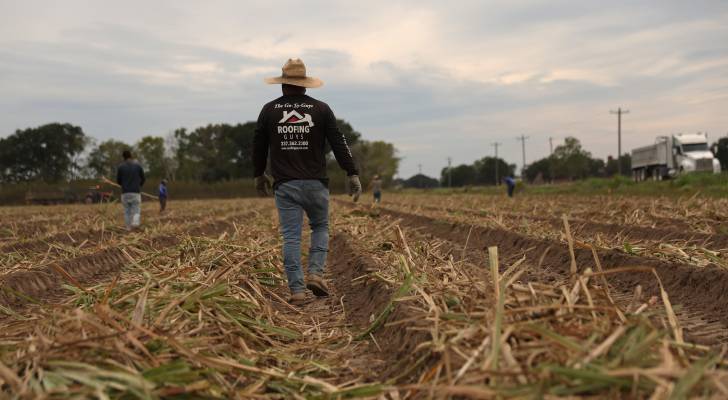
Drought conditions across the U.S. have hit farmers and ranchers hard — and the effects could soon show up at the grocery checkout.
The IRS recently announced tax relief for farmers and ranchers who have been forced to sell or exchange livestock as a result of drought conditions. (1)
Must Read
- Thanks to Jeff Bezos, you can now become a landlord for as little as $100 — and no, you don’t have to deal with tenants or fix freezers. Here’s how
- Dave Ramsey warns nearly 50% of Americans are making 1 big Social Security mistake — here’s what it is and 3 simple steps to fix it ASAP
- Robert Kiyosaki says this 1 asset will surge 400% in a year — and he begs investors not to miss its ‘explosion’
To qualify, farmers must operate in areas with a federal drought designation. The IRS lists eligible jurisdictions across 49 states, the District of Columbia and other regions that experienced exceptional, extreme or severe drought during the 12 months ending August 31. (2)
The relief allows farmers who had to sell livestock earlier than planned to defer taxes on capital gains from those sales or exchanges. Typically, farmers must replace livestock within two years to avoid tax implications, but the IRS is extending that period to four years — or possibly longer if drought persists.
A battery of challenges
U.S. farmers aren’t just dealing with extreme weather. They’ve also been hit by tariffs and labor shortages — a combination that could push food prices even higher.
Trade wars have taken a real toll on American farmers, particularly those caught in tariff tensions between the U.S. and China. Demand from China has dropped sharply, leaving many producers struggling.
Soybean farmers are especially hard hit. China stopped buying American soybeans after tariffs on Chinese goods were enacted in February. (3)
“When China quits buying, our prices go down,” Nebraska farmer Scott Thomsen told ABC News. The outlet reported that farmers exporting directly to Asia could face devastating losses if the Chinese market — the world’s largest soybean buyer — disappears. (4)
Tariffs are also driving up the cost of inputs like fertilizer and machinery. According to The New York Times, fertilizer imports face tariffs ranging from 10% to 30%, depending on the country of origin. (5)
Labor shortages are adding to the pain. A recent Politico report noted that many farmers are struggling to find workers, with many relying heavily on migrant labor to keep operations running. (6) The U.S. Bureau of Labor Statistics reported the agricultural workforce fell 7% — about 155,000 workers — between March and July.
“People don’t understand that if we don’t get more labor, our cows don’t get milked and our crops don’t get picked,” Pennsylvania dairy farmer Tim Wood told Politico.
Read more: Ultra-rich Americans are ditching stocks and real estate, says this investing legend — 5 assets they’re using to shockproof their millions
What does this mean for American consumers
The mounting challenges facing U.S. farmers could ripple far beyond rural communities. Some are calling it “farmageddon,” as growers fear what comes next.
According to the U.S. Department of Agriculture’s Food Price Outlook, the all-items Consumer Price Index for food was up 2.9% in August compared with 2024. (7)
The USDA’s Economic Research Service predicts overall food prices will rise another 3% in 2025, driven by changing trade patterns, plant and animal disease and extreme weather. The agency also cites higher interest rates, energy costs, labor shortages and consumer demand as key inflation pressures.
While the IRS tax relief will offer some breathing room for farmers battling drought, the industry faces a perfect storm of challenges.
The USDA says U.S. food prices rose 23.6% from 2020 to 2024. Whether consumers face even higher food prices in the years ahead could come down to how much government assistance farmers receive.
Americans may need to keep changing their shopping habits to cope with rising grocery costs. The Consumer Price Index forecast shows beef and veal prices could jump 11.6% in 2025, with pork and poultry climbing 1.4% and 1.9%, respectively.
Egg prices have fallen for five straight months, but they’re still projected to increase 24.8% for all of 2025. As for fresh vegetables, the USDA expects prices to remain roughly in line with 2024, despite month-to-month swings.
What to read next
- Want to retire with an extra $1.3M? See how Dave Ramsey’s viral 7-step plan helps millions of Americans kill debt and build wealth — and how you can too
- I’m 49 years old and have nothing saved for retirement — what should I do? Don’t panic. Here are 6 of the easiest ways you can catch up (and fast)
- There’s still a 35% chance of a recession hitting the American economy this year — protect your retirement savings with these 5 essential money moves ASAP
- This tiny hot Costco item has skyrocketed 74% in price in under 2 years — but now the retail giant is restricting purchase. Here’s how to buy the coveted asset in bulk
Join 200,000+ readers and get Moneywise’s best stories and exclusive interviews first — clear insights curated and delivered weekly. Subscribe now.
Article sources
We rely only on vetted sources and credible third-party reporting. For details, see our editorial ethics and guidelines.
IRS (1); IRS (2); The New York Times (3 5); ABC News (4); Politico (6); USDA (7.
This article provides information only and should not be construed as advice. It is provided without warranty of any kind.